In the greater suburbs of Geneva
DIDIER HEUMANN, ANDREAS PAPASAVVAS

We divided the course into several sections to make it easier to see. For each section, the maps show the course, the slopes found on the course, and the state of the roads. The courses were drawn on the “Wikilocs” platform. Today, it is no longer necessary to walk around with detailed maps in your pocket or bag. If you have a mobile phone or tablet, you can easily follow routes live.
For this stage, here is the link:
https://fr.wikiloc.com/itineraires-randonnee/de-coppet-a-geneve-cornavin-par-la-via-jacobi-4-70074413
It is obviously not the case for all pilgrims to be comfortable with reading GPS and routes on a laptop, and there are still many places without an Internet connection. Therefore, you can find a book on Amazon that deals with this course. Click on the title of the book to open Amazon.
If you only want to consult lodging of the stage, go directly to the bottom of the page.
The Swiss Friends of the Way of St. James was established in 1988 and boasts approximately 2,500 members. In 1989, an inventory of potential routes was undertaken, as there was scant knowledge about the routes traversed in Switzerland. The major routes coming from Germany and Austria were known. It was understood—or assumed—that pilgrims passed through Einsiedeln, Payerne, and Fribourg, and that was about the extent of the knowledge. The situation was hardly more elucidated for the routes in France or Spain. The major directions, abbeys, and convents were known, but details were entirely unknown. It remains a curious fact to encounter numerous pilgrims who refuse to deviate a single step from the route their ancestors took! They forget that medieval pilgrims hardly covered more than 5 to 10 kilometers a day, sometimes fording rivers by swimming or crossing at treacherous shallows, often seeking a viable path through vegetation. Asphalt was non-existent back then.
Thus, in Switzerland as in France, reliance was placed on the trails marked by regional pedestrian tourism organizations. When you follow the Via Podiensis in France, you are actually walking on the Grande Randonnée GR65 trail. In Switzerland, the Friends of the Way of St. James adopted the routes of Via Jacobi 4 and marked them, occasionally adding the scallop shell to signify Compostela, though this is rare. These individuals have done remarkable work, and the route through German-speaking and French-speaking Switzerland up to Morges is quite exceptional. If one dares to offer a slight critique, it would concern the choice of the route along Lake Geneva. Until St Prex, there is no issue as the route follows the lake shore. But beyond that, questions arise. The Lake Geneva basin is home to no less than 1,600,000 people, mostly clustered around the lake’s shores. So, why was a way routed through here? On the Via Podiensis, you will encounter only three towns with fewer than 20,000 inhabitants on your way to the Pyrenees. Thus, in this Lake Geneva region, the path could have been routed higher, beneath the Jura crests to Geneva. It was not, which is regrettable. And all pilgrims need directional signs.
As a result, this stage is not the most beautiful of the Via Jacobi in Switzerland. You will essentially be crossing the vast suburbs of Geneva, and there isn’t much exciting to see. You will pass by large estates hidden within private parks. You will hardly see any poverty here, although sometimes, in the smaller villages, opulence is not always the norm. A good solution might be to take a boat to Geneva from Coppet. This would afford you more leisure time to explore the city. However, for those dedicated to walking, here is what you will find on the route.
Difficulty level: Even today, the elevation changes (+158 meters/-145 meters) are negligible. These are merely slight undulations above the lake. As usual, there are almost always small preserved groves when crossing streams.
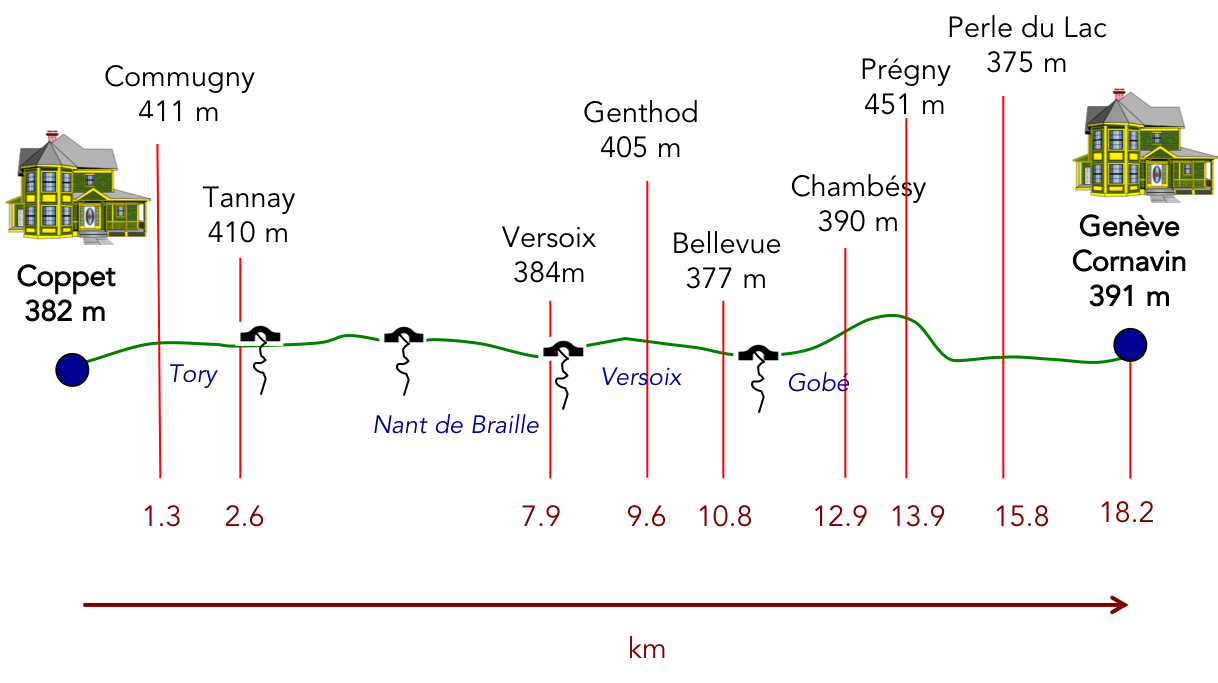
State of the Via Jacobi: Yet today, as one approaches cities, asphalt is ever-present:
- Paved roads: 14.2 km
- Dirt roads: 4.0 km
Sometimes, for reasons of logistics or housing possibilities, these stages mix routes operated on different days, having passed several times on Via Podiensis. From then on, the skies, the rain, or the seasons can vary. But, generally this is not the case, and in fact this does not change the description of the course.
It is very difficult to specify with certainty the incline of the slopes, whatever the system you use.

For those seeking “true elevations” and enthusiasts of genuine altimetric challenges, carefully review the information on mileage at the beginning of the guide.
We have divided the route into several sections, to facilitate visibility. For each section, the maps give the route, the slopes found on the route and the state of Via Jacobi.
Section 1: From the canton of Vaud to the canton of Geneva.
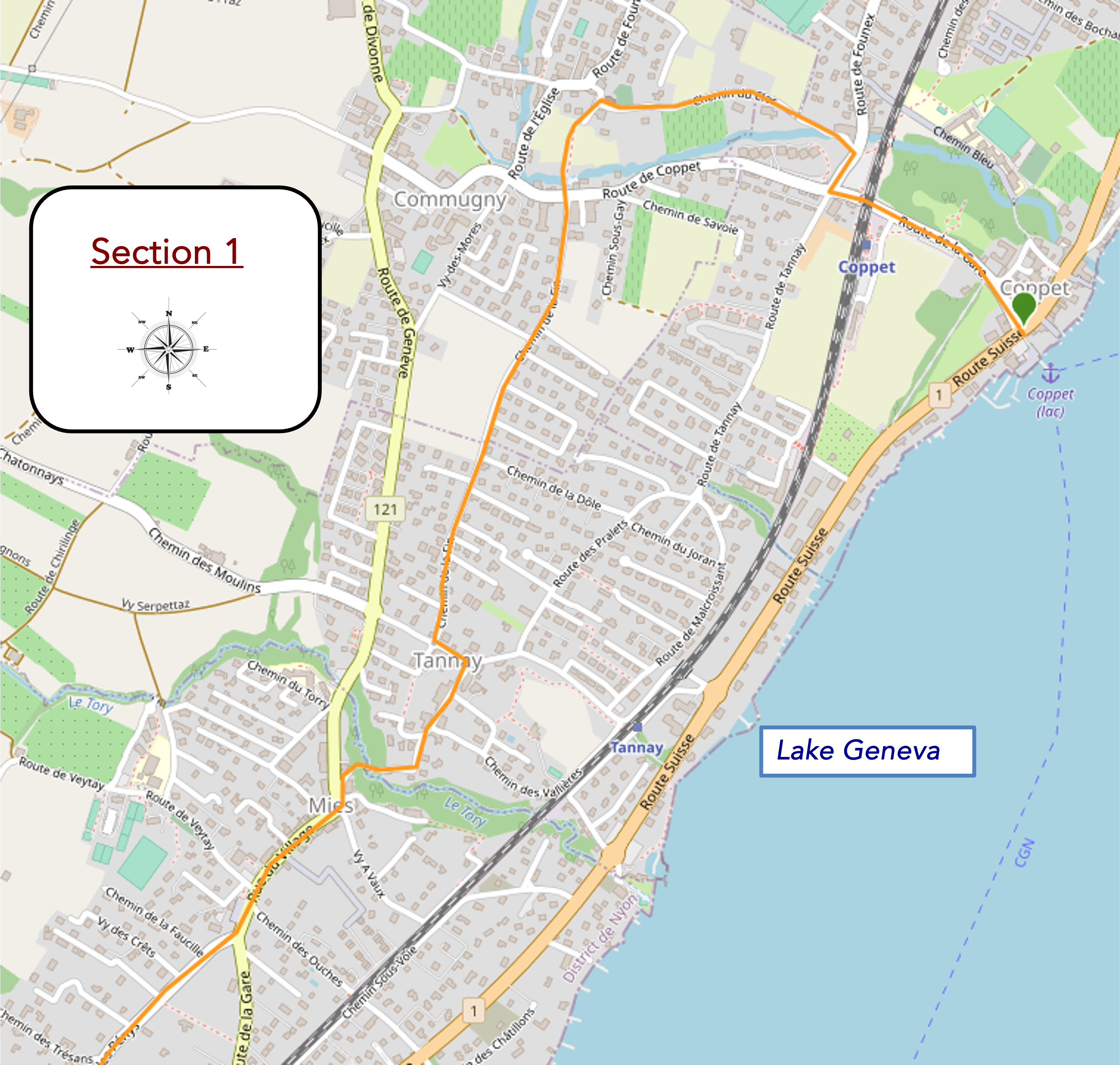
Overview of the route’s challenges: a journey without any difficulties.

| You set forth from the port of Coppet, an anchorage where the horizon blends into contemplation. There, the water jet stretches majestically, a vibrant symbol in the bay of Geneva, like a guardian deity watching over the waves. Here begins your journey, an odyssey stretching to the end of Switzerland. |
 |
 |
| The first section, traversed the day before, heads towards Commugny. It takes the direction of Versoix, leading you once again past Madame de Staël’s Castle, a relic steeped in history, and later reminding you of the frozen memories of the station. |
 |
 |
| Then, the climb up the road to the Commugny church brings you back to the church square. You have rejoined the Via Jacobi 4. Geneva lies more than four hours’ walk away. |
 |
 |
| A path winding through vineyards guides you towards the village of Commugny, accompanied by the murmur of the Doye stream, like whispers of ancient life in your journey. |
 |
 |
Commugny, Coppet, and Tannay stand as a triptych, their luxurious homes forming a labyrinth that captures the gaze. At a crossroads, a first intersection signals a fork towards the mysterious Chemin de la Fin, a road leading into the heart of Tannay

| As you walk, elegant homes parade by, silent witnesses to an elusive luxury. Yet, delicate grass insists on growing, defying the rampant urbanization that threatens its imminent disappearance. A poignant paradox, a nagging question: how long will this fragile balance last? |
 |
 |
| Finally, the entrance to Tannay reveals itself, like a theater of opulence where tall hedges stand as ramparts, jealously guarding the privacy of the residences. Every meter walked unveils more of this district’s discreet splendor, where luxury sometimes intertwines with elegance. |
 |
 |
| Here, no signs light your way, but there’s no fear of getting lost in this paved maze. Simply follow the irregular alignment of the stones… |
 |
 |
| …which inexorably guides you towards Chemin de la Petite Gatillarde, where the Via Jacobi 4 continues its journey. |
 |
 |
| The route then delves into a green haven, offering a welcome respite to the walker. A dirt path unfolds through the woods, crossing the Tory, a thin stream weaving between stones, like a nourishing vein. |
 |
 |
| But the tranquility is short-lived, as the path quickly leads you back to the road, heading towards Mies. |
 |
 |
| This last Vaudois bastion marks the threshold of the Canton of Geneva, where peaceful villages have transformed into commuter towns, erasing traces of an agricultural past. |
 |
 |

| The Via Jacobi emerges from Mies along a road lined with lordly homes, hidden behind thuja hedges or gates watched by cameras, remnants of an era where prestige still competes with discretion. |
 |
 |
Section 2: The long crossing of Versoix.
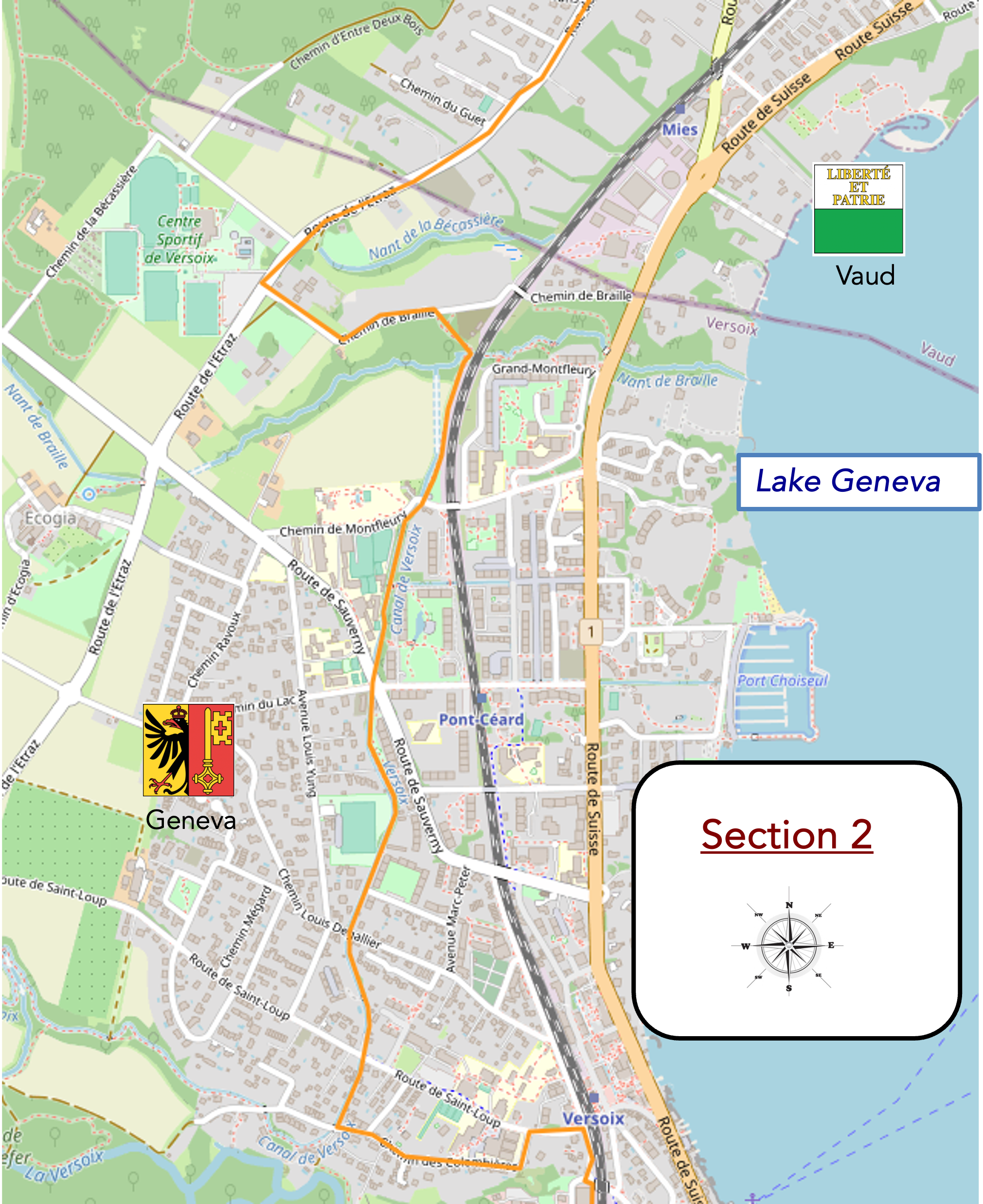
Overview of the route’s challenges: a route without any difficulty.
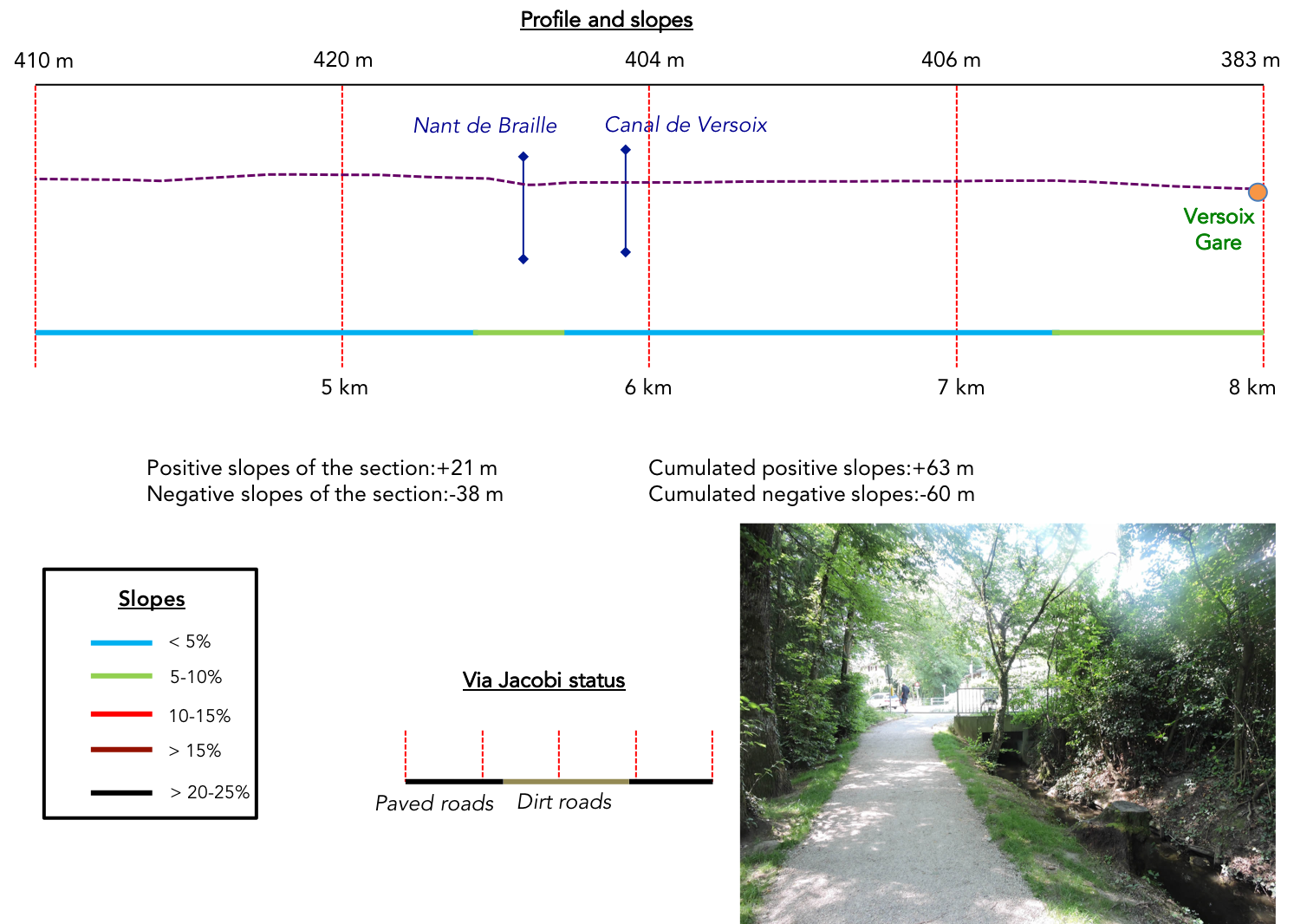
| The gates stand majestically, like iron sentinels, separating the world of opulence and elegance from that of dreams. Through these barriers, master houses parade, each vying in splendor, history, and mystery. Here is already Geneva, the city of watchmakers and financiers, where numbers dance to the rhythm of beating hearts in banks. |
 |
 |
| A breath of the countryside suddenly slips in, a patch of yellow earth emerging from the grey asphalt, vibrating with a forgotten life. The rapeseed, a golden carpet, defies rampant urbanization, offering an ephemeral spectacle, a reminder of what once was. How much longer will this green relic withstand the assaults of progress? |
 |
 |
| Near the Bécassière sports center and the Le Repère restaurant, the Via Jacobi moves away from the hustle and bustle, delving into the meanders of a countryside in trompe-l’œil. Through the Chemin de Braille, it reconnects with the very essence of nature, in a perfect illusion of rural tranquility. |
 |
 |
| An unusual stop appears on the horizon, where fairground workers and nomads gather, creating a shifting microcosm on the edge of the sedentary world. The bright colors of the carousels mix with ancient traditions, offering a surreal spectacle to those who appreciate it. |
 |
 |
| Beyond the tumult of the fairground workers, the Via Jacobi discovers an oasis of calm, a shy fountain hidden under the cover of trees. A secret path timidly escapes into the forest, inviting travelers to venture into the unknown. |
 |
 |
| It then crosses the Nant de Braille, a thin stream of water almost dried up, and emerges from the shadow of the woods, refreshed and renewed. Like an initiatory pilgrimage, each step on the path reveals a fragment of truth, a piece of unsuspected wisdom. |
 |
 |
| The Via Jacobi momentarily joins the murmur of the rails, following the railway like a child captivated by a wondrous tale. But soon, it veers away from this steel companion to explore new horizons, curious and insatiable. |
 |
 |
| Montfleury stands proudly on the route, an enigmatic neighborhood of Versoix, if ever there was one. |
 |
 |
| It is here that the Via Jacobi, intrepid and determined, crosses the gates of the Versoix Canal, ready to follow its winding course to the horizon. |
 |
 |
| The atmosphere of bucolic Versoix awakens here in a gentle symphony of greenery. Here, paths stretch between groves, offering a shaded alley where dogs frolic with contagious joy, under the age-old trees. |
 |
 |
| The dirt path, through its meanders, sometimes reveals discreet lanes descending towards the heart of Versoix. There, nestled among the foliage, the dwellings become modest, while beeches and oaks, like sentinels, brush their roots against the clear and shimmering water of the canal, offering a scene of eternal serenity. |
 |
 |
| The dwellings are quite discreet along the way. The beeches and oaks dip their roots into the murky and scant water of the canal. |
 |
 |
| From one stop to the next, the journey is sometimes punctuated by the laughter of children, propelled by the attentive arms of mothers walking the path. The wheels of the strollers then reveal an unpredictable dance on the packed earth, punctuating the surrounding calm with their fleeting bursts. |
 |
 |
| And thus continues the dance of barriers and lanes, an uninterrupted dance where each crossing reveals a new face, a new story, inscribing the traveler in the timeless journey of the path. |
 |
 |
After many crossroads with the nearby roads, the Via Jacobi suddenly yearns for an urban breath. It then leaves the murmur of the stream to flirt with the bustling arteries of Versoix, timidly approaching the station, as if to taste the effervescence of city life.

| A detour then invites you to stroll through the elegant quarters of Colombières, leading you into a maze of lanes where secret gardens of bourgeois houses flourish. |
 |
 |
Through a shaded park, where silence seems to whisper beautiful stories, the path is woven, carried by the majestic shadow of an ancient oak watching over the Civil Protection.

| Beyond the austere buildings of the Civil Protection, the Via Jacobi continues its quest, weaving gracefully through the paved arteries of the city center. |
 |
 |
| Soon, the route leads you to the doors of the Versoix station, where the rails stretch like the veins of a sleeping giant. Under the concrete arches, you plunge towards the peaceful waters of the lake. |
 |
 |
The Via Jacobi descends the road to the level of the railway bridge. But be careful here! It does not pass under the railway track but immediately turns right.
But as the lake is a stone’s throw away, let’s take a little walk there… We’ll come back to it later.

Section 3: Along the railway and the beautiful villas.
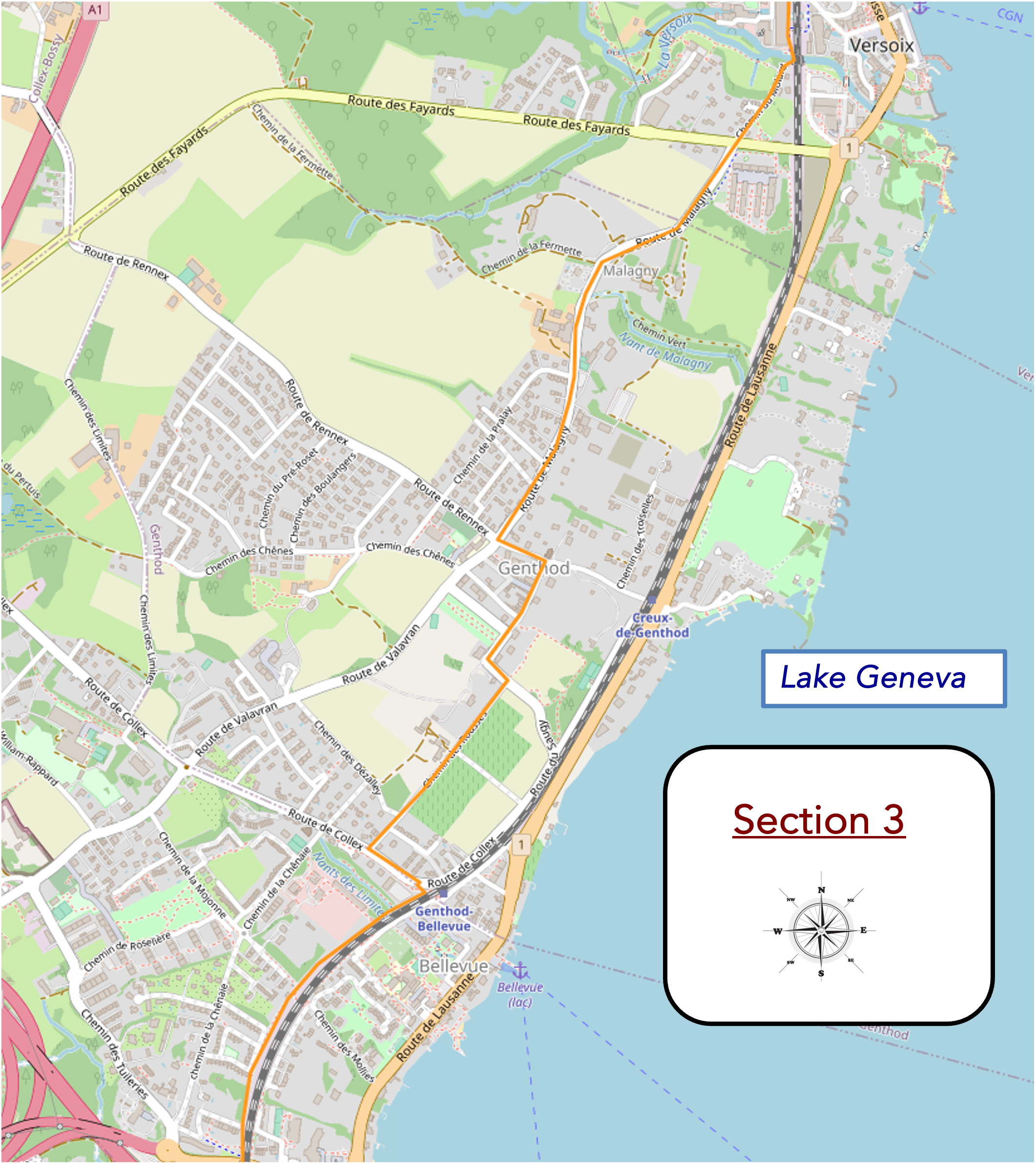
Overview of the route’s challenges: a journey with no difficulties whatsoever.
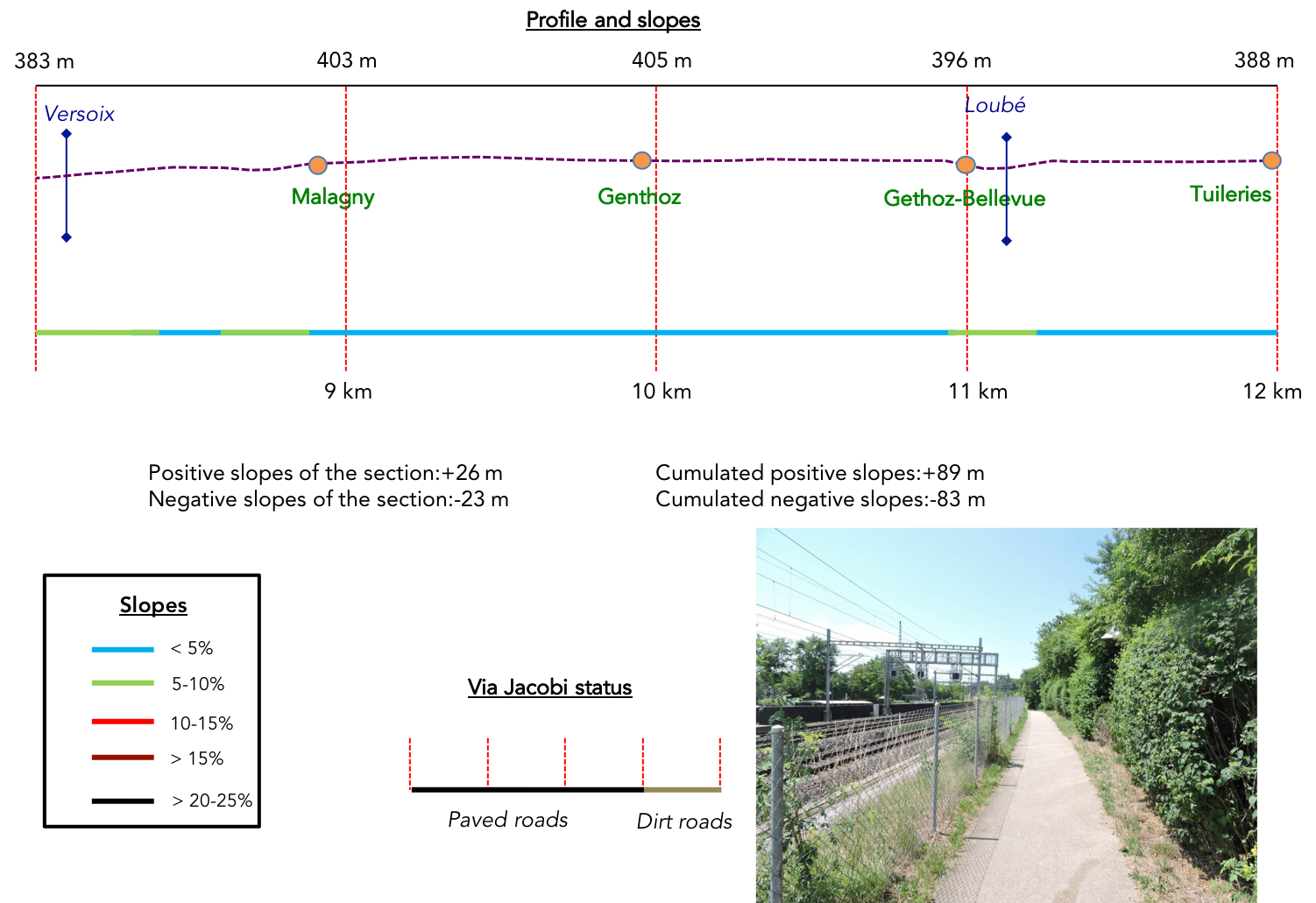
| Just after crossing the bridge, the imposing silhouette of the Faverger factory rises, a culinary gem etched in the memories of discerning gourmets. |
 |
 |
| The road, like an urban symphony, unveils its most beautiful melodies as it winds through some of the lively squares of this vibrant city, teeming with souls animated by the frenetic rhythm of modern life. With its 13,500 inhabitants, the city is fully oriented towards Geneva. |
 |
 |
| Just two minutes away from this urban bustle, Lake Geneva reveals itself, not in its frontal splendor, but in a dance of subtle and mysterious curves. In Versoix, contrasting with its neighbor Coppet, the bay of Geneva hides away, allowing the lake to sketch itself into an enchanting arabesque. Like a bewitching painting, each town and village along the sacred waters of Lake Geneva adorns its pier with flowers, thus offering a poetic haven to anyone swept away by the song of the waves. |
 |
 |
| After this short detour by the lake, let’s go back to the station and take Via Jacobi which resumes its course just before the tunnel under the railway tracks.
Here Via Jacobi runs alongside the railway line for a moment. |
 |
 |
| Far from the urban tumult, a distant rumbling awakens the traveler’s senses, drawing his gaze towards a striking spectacle. Beneath the impassive gaze of concrete giants, adorned with the ephemeral colors of urban artists, the Via Jacobi slips beneath the railway track. |
 |
 |
| There, in the tumultuous embrace of the underpass, springs the Versoix, a torrential river born from the steep flanks of the Jura mountains. Like a wild goddess, it unleashes itself under the gaze of onlookers, reminding us of the indomitable force of nature in the face of human imprint. |
 |
 |
From the distant peaks of Lausanne, the clear waters of the rivers descend like crystal tears from the secret folds of the Jura mountains, eternal guardians of the border between Switzerland and France.

| The road then stretches out, cleverly weaving its way between tall hedges standing like silent sentinels, which do not merely conceal misery in these privileged surroundings. |
 |
 |
| The Via Jacobi, marked by a solemn determination, soon crosses a more imposing artery, a path that seems to draw it towards the grand Saconnex, but the Via remains undeterred from its quest. |
 |
 |
| Its route then leads through Genthod, where it carves a parallel path on a narrow trail, skimming the wooded edges with unyielding grace. |
 |
 |
Here, in this setting where wealth is unapologetically displayed, characterful homes flourish, silent witnesses to the prosperity that reigns supreme. The elegant neighborhoods of Geneva, often relegated to the outskirts, reveal their subdued charm, where opulence meets discretion with disarming ease.

| True to its trajectory, the route continues along the road, lingering at the outskirts of the first houses of Genthod, venturing into the Malagny district with a curiosity filled with respect. |
 |
 |
| In the sinuous meanders of the Via Jacobi, turning a corner by a majestic manorial residence, the road reveals itself as an epic in motion. There, it stands, a humble sentinel, faithfully following the narrow strip that snakes parallel to the road rising towards the village. |
 |
 |
| Suddenly, the landscape transforms, revealing an imposing farm, an anachronistic but enduring witness in this almost urban setting. Here, anachronism becomes poetry. There are also wealthy peasants here, but it’s not just farms. |
 |
 |
| The road then unfolds, like a ribbon of adventure, through a landscape reminiscent of an impressionist painting. Opulent residences blend harmoniously with mysterious underbrush, while service buildings offer their discreet support to this perpetually moving community. |
 |
 |
It then reaches a crossroads, a stone’s throw from the village. The direction remains that of Via Jacobi 4 towards Les Tuileries and Pregny-Chambésy.

| Genthod resembles a true village. Within its core, a real microcosm unfolds, with its beating heart, its imposing municipal building, its church with contemporary lines, its castle, and its verdant gardens where shadows of the past dance. Among the standing homes, some display the haughty elegance of ancient times, defying the test of time, revealing the discreet splendor of refined opulence. This is apparently not Geneva’s poorest suburb! |
 |
 |
| A small road escapes from the heart of the village, gently sliding towards the shimmering shores of the lake. |
 |
 |
| Lined with vineyards, it reveals to its travelers the infinite horizon where the Jet d’Eau (Water Jet) of Geneva stands, like a majestic specter, an ephemeral mirage at the heart of the azure. Between rows of golden vines, a few vintners’ homes emerge, silent witnesses to a tranquil opulence, blending the art of cultivating the land with that of creating havens of life. |
 |
 |
| Soon, the road veers off, winding among opulent mansions, hidden behind the vegetal ramparts of lush hedges. Each home seems to be a statement of nobility, reserved for a small elite. |
 |
 |
| At the edge of the landscape stands the modest Genthod-Bellevue station. |
 |
 |
| There, a paved path unfolds parallel to the railway, dutifully following the murmur of iron wheels, glancing at the melodious stream of the Loubé. |
 |
 |
| Here, trains follow one another with a rhythmic cadence, like the regular beating of a heart vibrant with energy, pulsing in unison with the whispers of the surrounding nature. |
 |
 |
| A little further on, the Via Jacobi momentarily diverges from the tracks, offering the wandering soul a fleeting illusion of a return to the wild, before reality resumes its relentless course. |
 |
 |
But the symbiosis between man and machine remains unbreakable, and soon the path, like a faithful lover, finds the railway’s embrace near the quaint Tuileries station.

Section 4: In one of the chic suburbs of Geneva.

Overview of the route’s challenges: a route with no difficulties.
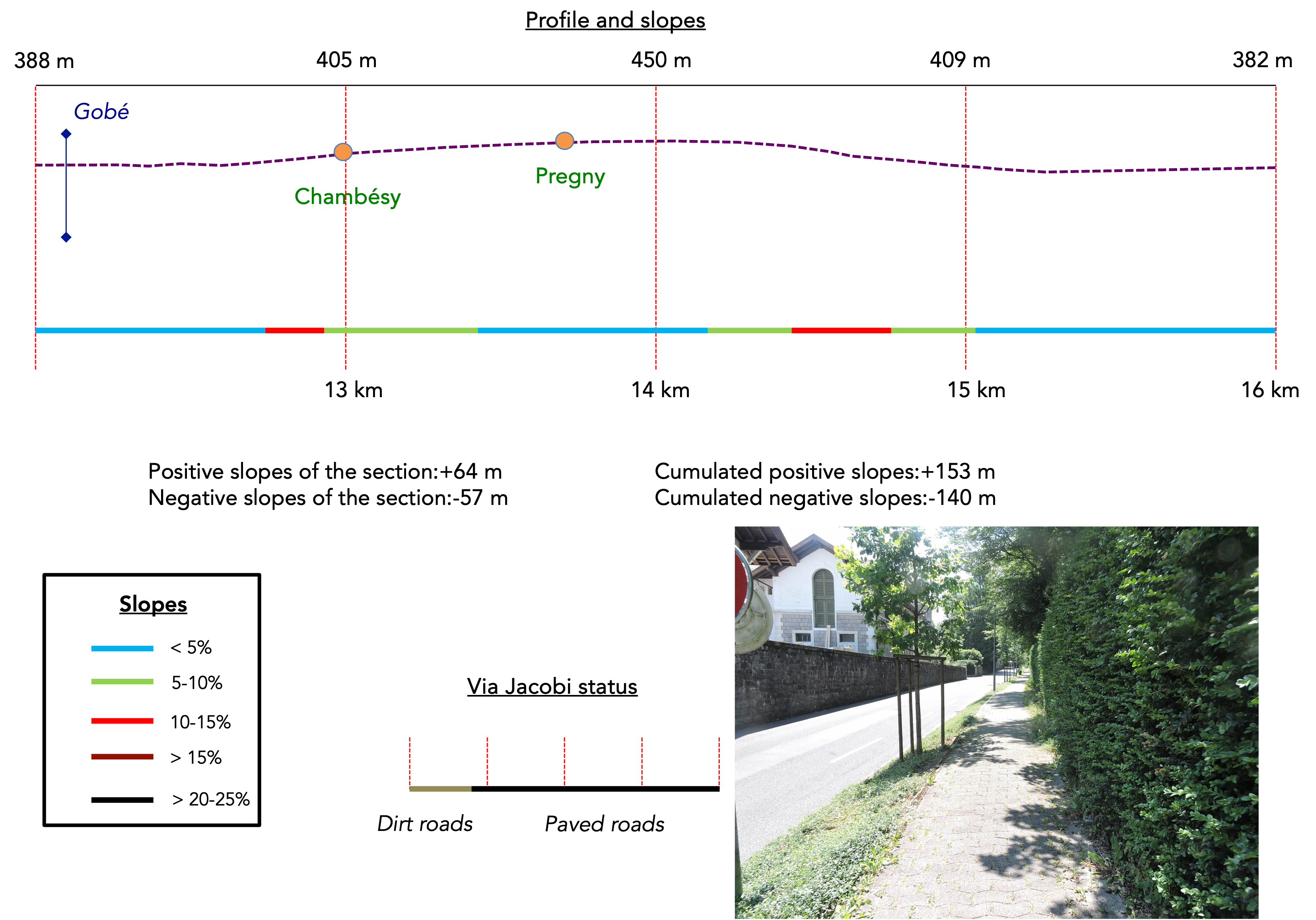
| As the familiar silhouette of Tuileries station fades into the distance, the path escapes onto the highway access road winding towards Geneva, caressing the shores of the majestic lake. A symphony of departures and arrivals mingles with the air, an incessant dance of hurried vehicles, while your path forges resolutely towards new horizons. |
 |
 |
| Continuing its course parallel to the railway line, the path becomes intoxicated with the metallic murmurs of trains speeding towards distant lands before reaching a crossroads. |
 |
 |
But beware, a decisive turn approaches! The path is about to abandon the iron rails to embrace the discreet charm of the Chemin de l’Ancienne Fontaine.

| An ascent unfolds boldly towards Chambésy Village. |
 |
 |
And behold, marvel of marvels, a fountain with two faces reveals itself to your astonished eyes. Like a marvel of craftsmanship, it offers its generous waters to those who can tame them, a living metaphor of life’s duality, with its myriad facets to explore.

| Then comes the only steep incline of the journey, a marked ascent towards Chambésy Village. |
 |
 |
| The village stretches as far as the eye can see, a ribbon of life unfurled between the hills, but for you, it boils down to the essentials: a café-restaurant and a crossroads of roads. |
 |
 |
| The road then unfolds towards Pregny, climbing a small hill overlooking the lake, like an invitation to contemplate the azure vastness that stretches as far as the eye can see. In this muted setting of stately homes, where luxury blends with tranquility, each stone tells a story, each window whispers a secret. |
 |
 |
Further up, the road crosses paths with Château Perrot, an architectural marvel that rises like a sugar candy, a symbol of great opulence. It reminds us that behind every facade lie lives unfolding in the shadow of ancestral walls.

| At the gates of Pregny, the road wanders near the Permanent Mission of France to the United Nations, an imposing presence that attests to the strategic importance of this region in international affairs. |
 |
 |
|
Pregny, the beating heart of the eponymous commune, flourishes like a jewel nestled in the hills. Here, every patch of greenery tells a story, a tale woven with luxury and grandeur. Majestic estates, with their imposing mansions and lush gardens, stretch languidly under your gaze. But that’s not all; a plethora of foreign permanent missions dot the hillside, like emissaries of global diplomacy. Among the illustrious residents, the Aga Khan and the Rothschild family stand out, enamored of this prestigious haven. And what can be said of the castles punctuating the landscape, like sentinels of history, guardians of the secrets of the past? Five of them, majestic and timeless, watch over Pregny with sovereign grace. We won’t be exploring them all today. So, the road passes through the center of the village, if we dare say so…
|
 |
 |
| The road quickly escapes the village to get lost in the verdant mazes of Parc de Penthes, otherwise known as the enchanting Garden of the Empress. |
 |
 |
| This vast estate, evoking the splendor of a bygone era, was once the property of Joséphine De Beauharnais, a legendary figure nicknamed the “beautiful creole” born under the tropical skies of Martinique. A tormented wife of Alexandre de Beauharnais, taken by the guillotine of the Reign of Terror, she crossed paths with General Bonaparte, offering him her heart and her name in a second marriage that would elevate her to the pinnacle of the imperial court. But the weight of history bore down on her frail shoulders, as the empress remained childless, condemned to the solitude of misfortune. Relegated to the shadow of Malmaison Castle, she survived oblivion, weaving her legend over the years. Yet, here in Geneva, the memory of Joséphine shines brightly, immortalized by the posterity of her blood. Among her children, it is Hortense who stands out, mother of the illustrious Napoleon III. In 1810, Joséphine acquired the majestic property of Pregny, transforming the medieval castle into a refuge befitting her grandeur. Within its walls, she wrote her history, weaving the threads of her memories with insatiable passion. And even when death came for her, her legacy endured, passed on to her daughter Hortensia, before being handed over to a notable Genevan. Today, this historical treasure, acquired by the City of Geneva in 1983, offers itself to the gaze of visitors, transforming the estate into a haven of peace. |
 |
 |
| Thus, a modest road, forgotten by the splendors of royalty, the Chemin de l’Impératrice humbly winds along the majestic contours of the Domaine de Penthes. In the shadow of towering trees, it eludes the eye, preserving its modesty in the face of the resplendent splendor reigning over Pregny and its surroundings. An irony of fate, one might say, that a road with such a prestigious name content itself with a discreet existence among many others. It timidly stretches to the depths of the public park, skirting the restaurant and Château de Penthes with a shy glance, neighboring Château de Pegny, La Tour, once inhabited by Joséphine herself. A simple detour in history, where the ghosts of the past whisper to the ears of lost strollers. |
 |
 |
 |
 |
| Descending ever lower, the Chemin de l’Impératrice crosses paths with the Permanent Mission of Italy to the international institutions, a diplomatic bastion where life buzzes to the rhythm of negotiations and alliances. In this bustling hive that is Geneva, nearly 4,000 souls of the diplomatic corps find refuge, their cars adorned with the immutable CD plate rivaling in number with the city’s taxis. A captivating spectacle, where the world’s stakes are reflected in the game of license plates. |
 |
 |
| The road, tireless, continues its descent, bravely crossing the iron rails to emerge at one of the majestic entrances of the Botanical Garden. A haven of tranquility and contemplation, this vegetal gem, cherished by Geneva’s families, extends in a symphony of colors and fragrances. In the expert hands of the gardeners of the City of Geneva’s Botanical Garden, this green sanctuary comes to life, offering visitors a refuge where the mind wanders along flowery paths. |
 |
 |
| The Chemin de l’Impératrice finally reaches the famous Route de Lausanne, an emblematic artery often besieged, like a vital artery pulsing to the east of the city. There, one must humbly follow the sidewalk, insinuating among the incessant flow of vehicles bursting from the highway, like impetuous waves crashing on the shores of daily life. |
 |
 |
| Soon, the Via Jacobi joins the dance, unfurling its path before the majestic entrance of the Botanical Garden. |
 |
 |
| Facing this haven of greenery stands the unwavering edifice of the WTO/OMC (World Trade Organization), a monument of global diplomacy shaping the economic destinies of our planet. Like an impassive colossus, it reigns at the crossroads between the Route de Lausanne and Avenue de la Paix, like a vigilant guardian watching over the incessant flows of international trade. And as the gaze loses itself in the horizon of possibilities, other bastions of the UN, such as WHO, ILO, or ICRC, stand taller, like sentinels of peace, near the majestic Place des Nations. |
 |
 |
Section 4: All the way to the end of Switzerland.
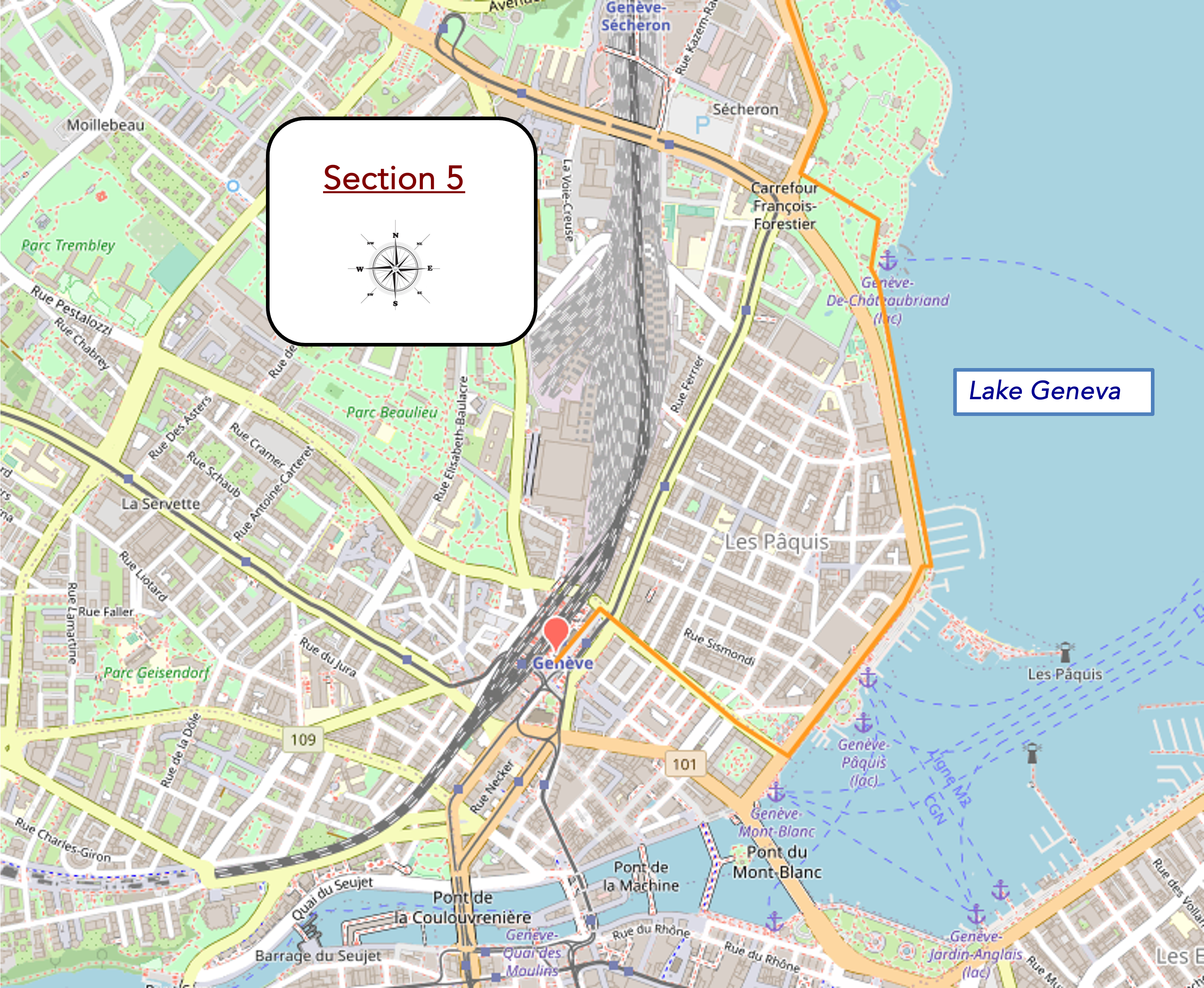
Overview of the route’s challenges: a route with no difficulties.
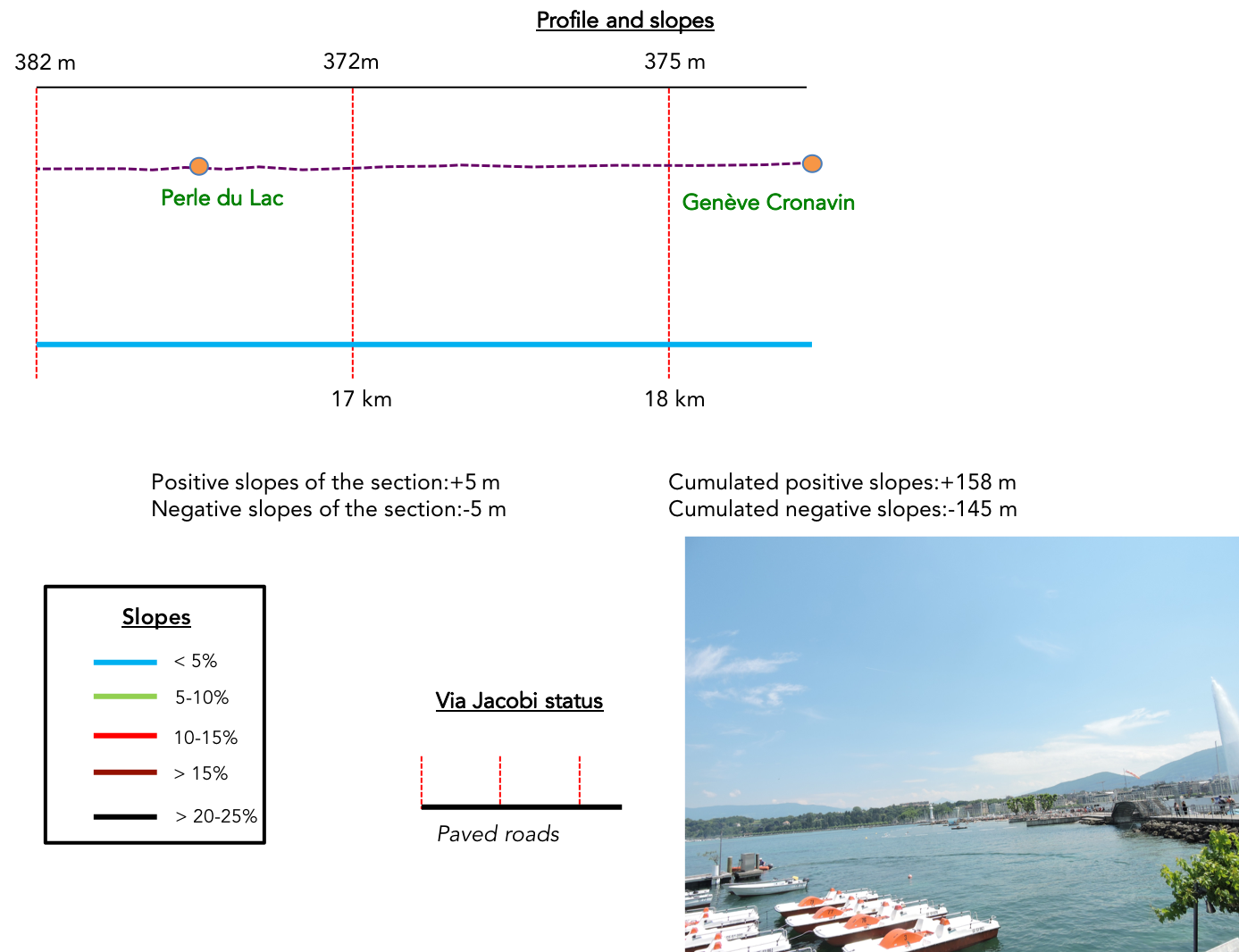
| The Via Jacobi, like a silver thread woven into the fabric of the city, gracefully ascends the Route de Lausanne, skirting the Barton Park with determination until it reaches the very entrance of the haven of greenery that is Parc de la Perle du Lac. |
 |
 |
| Further on, it plunges into the welcoming embrace of the park, where the foliage gently caresses the shores of the lake with a benevolent embrace. It is here, near the restaurant silently watching over the waters, that tranquility extends as a delicate offering to strollers and passersby. |
 |
 |
| From then on, one only needs to be carried away by the gentle rhythm of the parks, where the crowd joyfully gathers on sunny days, along Quai Wilson and Quai du Mont Blanc. Or, for the more hurried, to surrender to the rails of the small train, a promise of a quicker escape towards the spray of the Jet d’Eau. And there, on the horizon, stands the majestic Salève, a promise of future adventures for those who continue the Way to Santiago, following the traces of the Via Gebennensis. |
 |
 |
| You then approach the famous Jet d’Eau with soft steps, as the path leads you to the Baths of Pâquis, a renowned spot for swimming in Geneva. |
 |
 |
| The Via Jacobi, a faithful guide in this urban labyrinth, ultimately leads you to the heart of the action, near the bustling port, in the imposing shadow of the majestic Jet d’Eau. Right there, next to it, the Mont Blanc Bridge spans the harbor. |
 |
 |
In the background rises the elegant silhouette of the cathedral, piercing the sky above the Lower Streets of the city.

| And yet, there is no need to continue to Mont Blanc Bridge to reach the station, as at the height of the Brunswig Monument, this imposing mausoleum erected at the request of Duke Charles II of Brunswick, exiled, who bequeathed his entire fortune to the city, the solution presents itself: just follow Rue des Alpes leading straight to the station. Gare Cornavin is the true beating heart of the city. |
 |
 |
In general, the Via Jacobi has two well-defined objectives: on one hand, to serve as a guide for Swiss tourists eager to discover their own country in a new light, and on the other hand, to offer pilgrims coming from Germany or Eastern countries a route that will lead them to Le Puy-en-Velay, France, often mistakenly considered as the true starting point of the Way of Compostela. In the context of this description, we will detail Geneva as the first stage of the Via Gebennensis, this path taken by pilgrims to reach Le Puy-en-Velay.
It is undeniable that the Way of Compostela is a story with multiple twists and turns. It is interesting to note that most pilgrims choose to start from Sarria, located only 100 kilometers from Santiago. This strategic choice allows them to reach their final goal: to touch the Grail of pilgrimage, the precious certificate of the Way of Compostela. This may seem like a simplification of the experience, a kind of shortcut that certainly undermines the journey undertaken by those who have trodden the paths of all of Europe, carrying the weight of their sack on their shoulders. But such is life, with its unexpected detours and its disconcerting paradoxes.
Accomodation on Via Jacobi
• Camping communal, Route de Suisse 58, Tannay; 078 855 97 27; Accueil jacquaire, dinner, breakfast
• Christine Kaltenrieder, Ch. Des Vallières 17, Tannay; 022 776 31 50/079 314 30 42; Accueil jacquaire, dinner, breakfast
• Auberge du Lion d’Or, Route du Village 2, Tannay; 022 776 04 23; Hotel, dinner, breakfast
• Fabiola Gavillet, Route suisse 73, Mies; 022 779 43 00; Accueil jacquaire, breakfast
• Hôtel de la Couronne, Rue du Village 390, Mies; 022 755 24 90; Hotel, dinner, breakfast
• B&B Raess, Chemin Montfleury 31, Versoix; 022 755 28 52/079 549 22 11; Guestroom, breakfast
• Hôtel des Balances, Route suisse 33, Versoix; 022 755 37 68; Hotel***, dinner, breakfast
• Genève Cottage, Route suisse 190, Versoix; 022 369 00 03; Hotel***, dinner, breakfast
• Lake Geneva Hotel, Versoix; 022 907 81 11; Hotel***, dinner, breakfast
• B&B Abel, Pré-des-Fourneaux 11, Genthod; 022 958 04 44; Guestroom, breakfast
• Gîte, Rue Rothschild 30, Genève; 022 732 62 60; Auberge de jeunesse
• Centre social protestant, Quai du Mont Blanc, Genève; 022 732 29 74; Accueil chrétien, dinner, breakfast
• Home St Pierre, Cour St Pierre 4, Genève; 022 310 37 07; Gîte, breakfast
There are numerous accommodations in a large city. So, for other accommodations that are not cottages, consult the Internet or the Geneva Tourist Office (022 909 70 00).
Feel free to add comments. This is often how you move up the Google hierarchy, and how more pilgrims will have access to the site.
|
 |
Back to menu |








































































































































































































